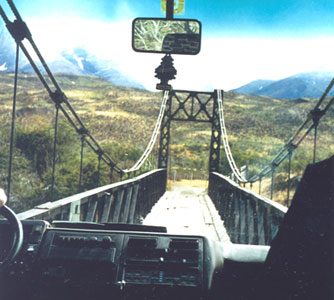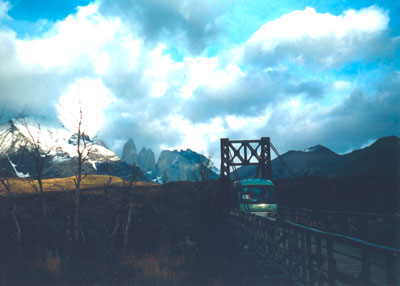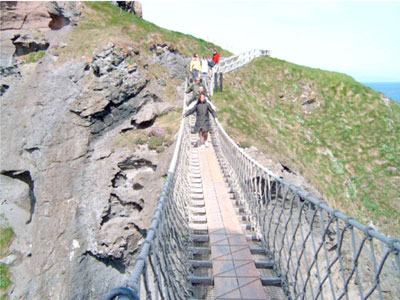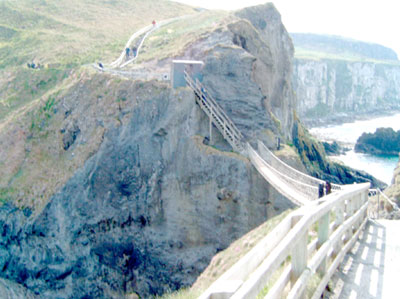Cross that bridge
We gave you this assignment: name a bridge (outside of the USA) that, for whatever reasons, is exciting to cross. Tell where it is (and, if necessary, how to find it) and approximately when you were there. Did you cross it on foot? By car? By train? Include your impressions. You may write about more than one bridge.
We printed a few responses in the March 2010 issue. Here are a few more, with more to come. If you have one to add, write to Cross That Bridge, c/o ITN, 2116 28th St., Sacramento, CA 95818, or e-mail editor@intltravelnews.com (include the address at which you receive ITN). With photos, include captions.
Suddenly, it is there. A stark skeleton of steel and concrete appears at the end of a market street in Kanchanaburi, a small town northwest of Bangkok, Thailand. It is the Tamarkan Bridge, aka “The Bridge on the River Kwai.”
This bridge was a crucial part of the Thailand-Burma Railway, built during World War II by the Japanese Imperial Army using Allied prisoners of war and Asian laborers. It would help in moving supplies the 250 miles from Bangkok to Rangoon without having to take a 2,000-mile sea voyage (exposed to submarine attacks).
Several kilometers away, in the Chung Kai cemetery, row upon row of white grave markers preserve the memory of 1,700-plus POWs, part of the more than 13,000 POWs and tens of thousands of civilians who died from torture, malnutrition, overwork and disease during the building of the rail line.
It is an eerie feeling walking across the Tamarkan Bridge, as we did in September ’03. The footing is treacherous, since the crossing involves walking between the rail lines on the sleepers, with the river 25 meters below visible in the gaps. Everything is hard and worn and, despite the heat, feels cold.
The view is not impressive — a muddy river meandering between flat green banks. The reason for going is not the view and certainly not the architecture but the feeling of awe occasioned by a living monument to the ghosts of gallant men.
To appreciate the Tamarkan Bridge, take nothing more than an open mind and a sense of empathy for the thousands brutally killed there. Also check out the JEATH War Museum in Kanchanaburi; it is a replica of the bamboo huts of the prison camps. The drawings and memorabilia make it a very worthwhile detour.
Christopher Hartley
Ormond Beach, FL
The soaring Rio-Antirrio Bridge, linking the Peloponnese to mainland Greece, is one of the most amazing bridges I’ve seen in all my trips.
Heading from Olympia to Delphi, I saw it from our coach while on Globus’ “Continental Odyssey” tour in August ’08.
The cable-stayed bridge, which crosses the gulf near Patras, was inaugurated on Aug. 7, 2004, a week before the Summer Olympics in Athens.
Marian Quick
Glenshaw, PA
After six visits to Australia, one of my fondest memories still remains my climb up the Sydney Harbour Bridge (aka “the coat hanger”), which I did in 2005.
I was fortunate in that I was able to go at 5 o’clock in the afternoon. That way, I could see Sydney in the daylight going up and with the night lights on as I was coming down.
It is definitely worth the trip (and the money) for those who want to see the city from another angle. You don’t need to take much, because you are fitted with a jumpsuit and will not be allowed to take your own camera with you.
Bill Ashley
Washington, DC
Climbing the Sydney Harbour Bridge, with guides, costs AUD258 (near US$239). Contact BridgeClimb (3 Cumberland St., The Rocks, Sydney, Australia; phone +61 [0] 2 8274 7777).
Torres del Paine National Park in Chile is a wonderful place to visit, and one little bridge was an adventure to cross in February ’99.
The bus for our group of 12 was quite small, but it was too large for this bridge, so when we arrived in the park, we changed to Hotel Las Torres’ smaller bus.
It was fun watching the bridge railing pass by about an inch from the window! We made the trip a number of times and always marveled at the driver’s steadiness as he crept that bus across the bridge, never brushing the sides once.
A pedestrian bridge in the park was somewhat of an adventure also.
We were going to Lago Grey and it was a day of blustery wind and rain, but that didn’t stop us. The long hike to the lake started with our crossing the Pingo River on a bridge made of wooden slats and open wire/mesh sides. It was swinging and bouncing in the wind, and only two of us were allowed on it at one time. Believe me, that day we really had to hold onto the cables to keep from being blown over!
Allyn Burke
Diamond Springs, CA
Carrick-a-Rede (Rock in the Road) is an island just off the north coast of Northern Ireland and near Ballintoy, County Antrim. The bridge’s setting is as exciting as its history is interesting.
Why a bridge to an uninhabited island in the first place? The channel between the island and the mainland has, through recorded history, been a major route for salmon going to and from a major spawning ground. The bridge allowed fishermen access to the beach, where they would anchor nets on the shore and extend them across the channel by boat. As late as the 1960s, 300 fish would be caught each day, but by 2002 only 300 were caught all season.
The bridge, now owned by the National Trust, is dismantled every fall to keep it from deteriorating in the winter. It is reerected each year prior to Easter. The suspension is now by wire rope instead of hemp.
On my visit to Carrick-a-Rede in spring 2005, for the half mile from the parking lot to the bridge I found a treasury of magnificent scenery along the headlands.
Once you reach the bridge, its 65-foot length appears daunting. Once you are on the swaying structure, the view to the sea 100 feet below is stomach-tightening. There is no record of anyone falling off the bridge, but some tourists have found the return trip too daunting and have had to be taken back to the mainland by boat.
David Lowe
Fullerton, CA





